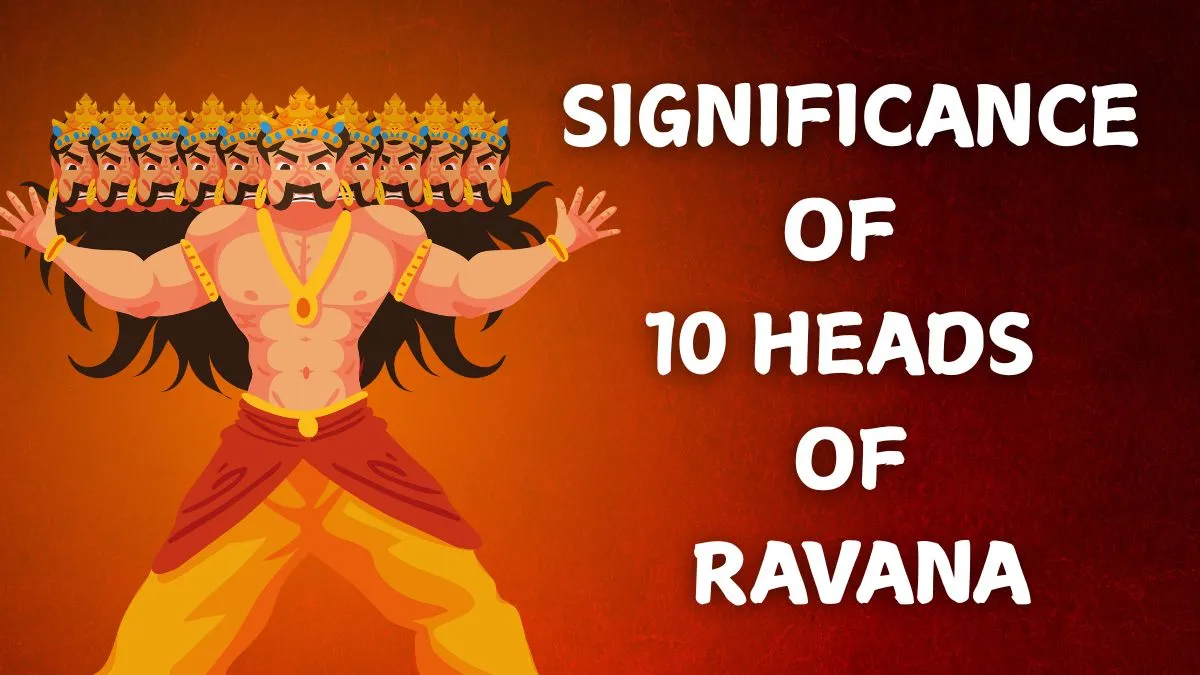- By Kashish Rai
- Thu, 02 Oct 2025 12:32 PM (IST)
- Source:JND
Dussehra 2025, also known as Vijayadashami, is one of the most celebrated festivals in Hindu culture, marking the timeless story of Lord Rama’s victory over Ravana. The festival brings communities together to witness Ravan Dahan, where effigies are burnt in a grand spectacle of fire and fireworks. Dashanan or Ravana, the powerful ten-headed king of Lanka, is remembered for his extraordinary intelligence, strength and influence. Each of his ten heads reflects the complexity of his personality, embodying knowledge, ambition, desires, and emotions that made him both formidable and flawed.
On the sacred occasion of Vijayadashami or Dussehra, let us check out the significance of the 10 heads of Ravana below:
Dussehra 2025: Significance Of 10 Heads Of Ravana
1. Kama (Lust): The head of Kama reflects Ravana’s uncontrolled desires and lust. It shows how unchecked cravings can dominate the mind and lead to destructive actions. This head reminds us to exercise self-restraint, cultivate respect for others, and focus on meaningful relationships rather than being enslaved by fleeting passions.
2. Krodha (Anger): Krodha represents intense anger and aggression. It signifies Ravana’s quick temper that often clouded his judgment. This head teaches the importance of controlling anger and responding calmly to challenges. Learning patience and emotional balance allows one to make thoughtful decisions and maintain harmony in personal and professional life.
3. Moha (Attachment/Delusion): Moha embodies attachment and delusion. It reflects Ravana’s inability to see reality clearly due to strong emotional bonds and illusions. This head reminds us to detach from unhealthy dependencies and perceive situations objectively. Letting go of false attachments helps nurture clarity, inner peace, and wiser choices in life.
4. Lobha (Greed): Lobha signifies greed and excessive desire for possessions. It mirrors Ravana’s insatiable hunger for wealth and power. This head teaches that uncontrolled greed leads to moral compromise and unhappiness. Practising contentment and generosity encourages a balanced life where material ambitions do not overpower ethical values or personal well-being.
5. Mada (Pride/Ego): Mada represents pride and ego. It reflects Ravana’s inflated self-importance and belief in his invincibility. This head reminds us that arrogance can isolate and harm relationships. Embracing humility and self-awareness allows growth, fosters respect from others, and prevents the destructive consequences of an unchecked ego.
ALSO READ: Dussehra 2025: 7 Lesser-Known Skills Mastered By Ravana You Do Not Know Much About

Ravana’s ten heads represent human flaws like lust, anger, greed, ego, and delusion, teaching lessons on self-control and righteousness. (Image Source: Canva)
6. Matsarya (Envy/Jealousy): Matsarya embodies envy and jealousy. It shows Ravana’s tendency to compare himself with others and feel discontent. This head teaches that jealousy breeds negativity and disrupts peace of mind. Focusing on personal growth and celebrating others’ successes creates harmony, strengthens relationships, and cultivates inner satisfaction.
7. Manas (Mind/Wavering Thoughts): Manas signifies a restless and wavering mind. It reflects Ravana’s lack of focus and susceptibility to distractions. This head reminds us to train the mind through discipline and mindfulness. A steady mind promotes clarity, better decision-making, and the ability to overcome challenges without being swayed by impulsive emotions.
8. Buddhi (Intellect/Misuse of Knowledge): Buddhi represents intellect and the potential misuse of knowledge. It reflects Ravana’s brilliance that was often applied for selfish purposes. This head teaches that wisdom without ethical guidance can harm oneself and others. Using intellect with integrity and compassion leads to meaningful accomplishments and positive influence.
9. Chitta (Willpower/Desires): Chitta embodies willpower and strong desires. It reflects Ravana’s intense determination often driven by selfish aims. This head reminds us to channel willpower towards righteous goals. Controlled desires combined with focus and discipline allow success while avoiding actions that bring harm or imbalance to life.
10. Ahamkara (Ego/Self-importance): Ahamkara signifies ego and self-importance. It shows Ravana’s obsession with personal supremacy and recognition. This head teaches the dangers of allowing pride to dominate choices and relationships. Practising humility, empathy, and self-reflection helps maintain balance, respect, and meaningful connections while preventing the pitfalls of overconfidence.
ALSO READ: Dussehra 2025: 7 Profound Life-Lessons To Learn From Ravana
Ravana's ten heads provide enduring insights into human nature, showing what happens when desire, anger, and ego are not kept in check. Dussehra is a reminder to conquer these failings, develop good qualities, and find balance. Thinking about what Ravana represents can inspire us to be more self-aware, disciplined, and to act rightly in our daily lives.
